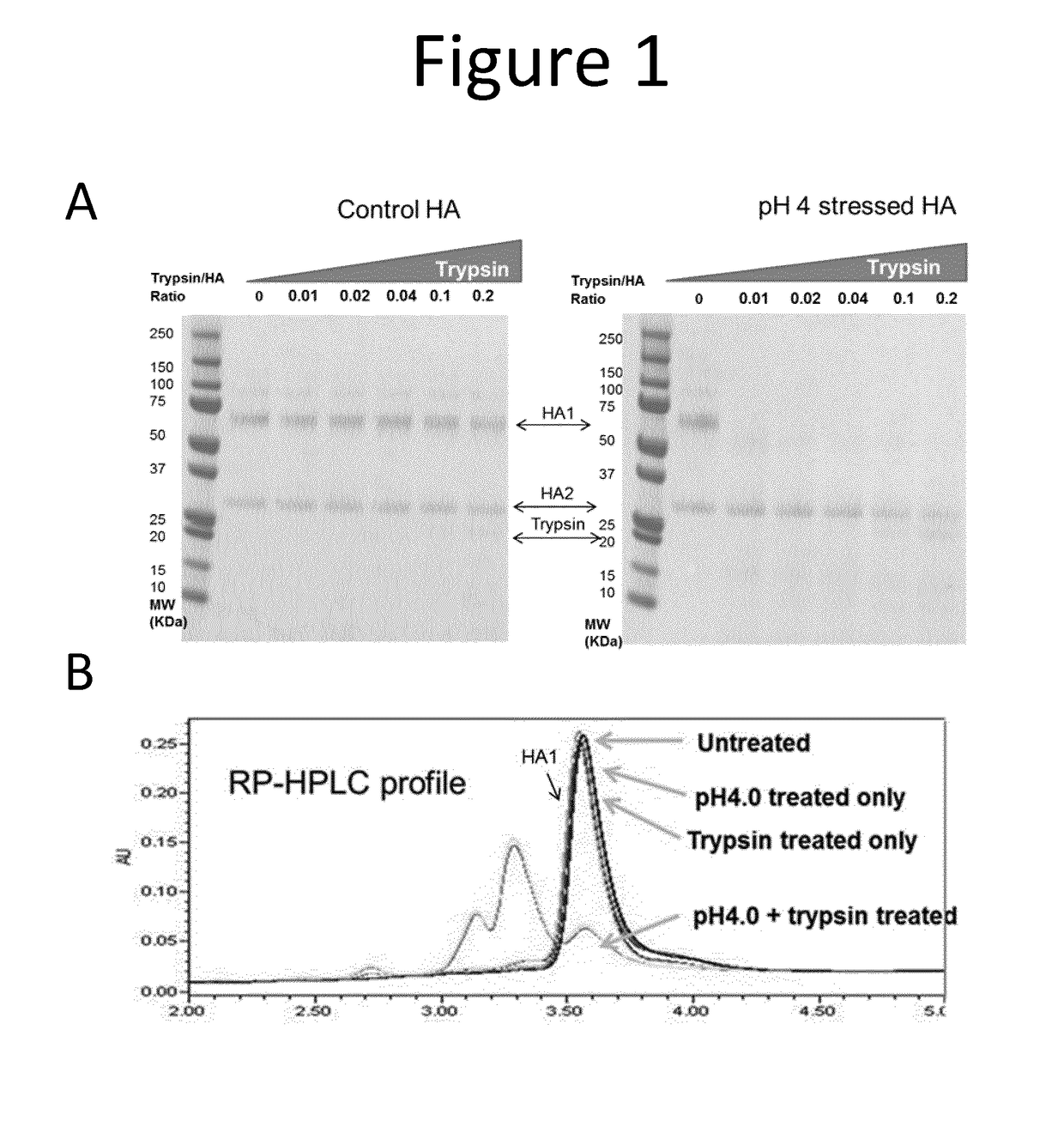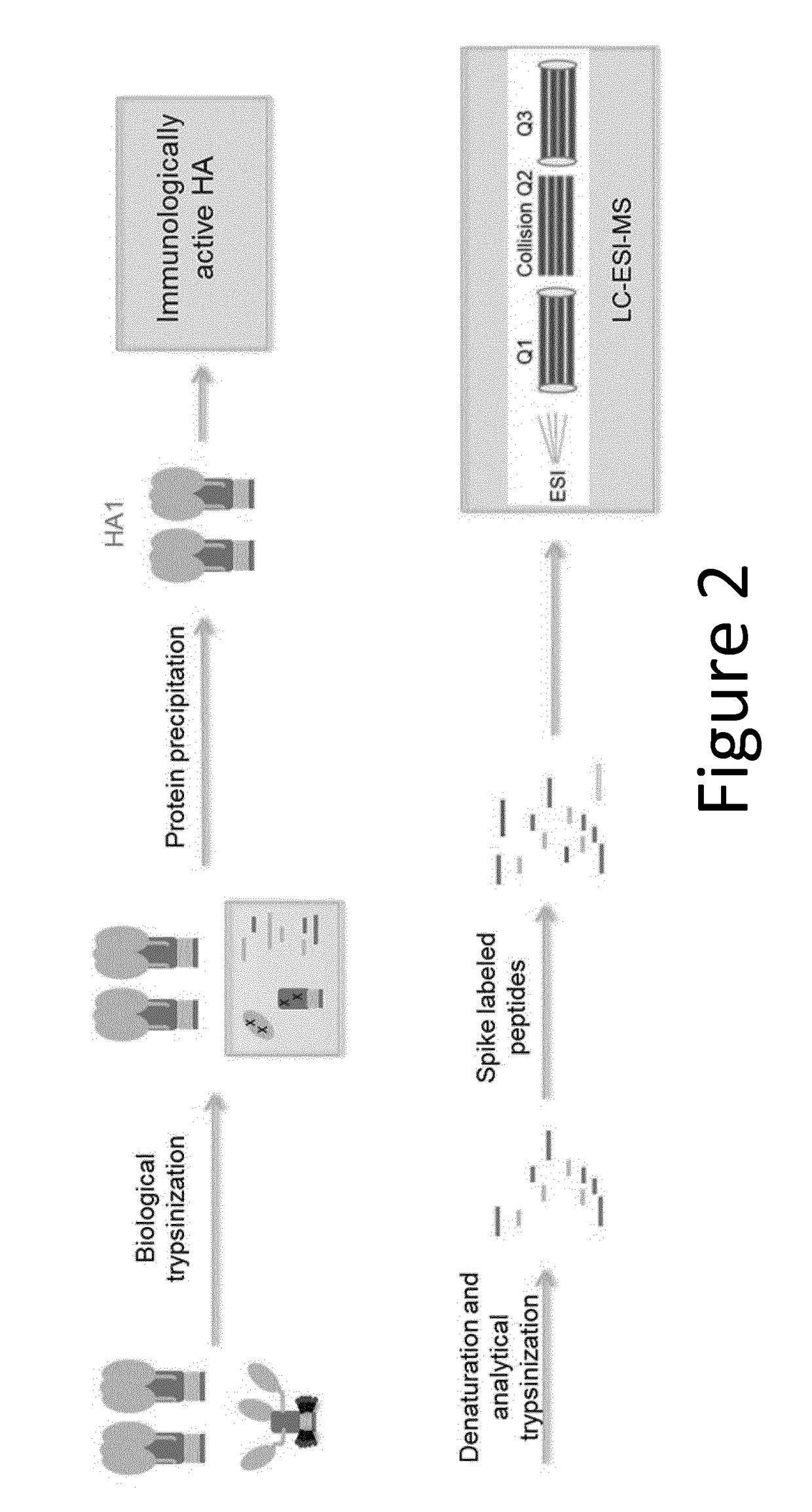Influenza potency assays
- Summary
- Abstract
- Description
- Claims
- Application Information
AI Technical Summary
Benefits of technology
Problems solved by technology
Method used
Image
Examples
example 1
ment by Biological Trypsinization
[0228]Influenza viral surface HA primarily exists as a trimer in the pre-fusion state, which is the most immunologically relevant state. HA can undergo an irreversible transition to post-fusion state under various stress conditions. Post-fusion HA does not elicit a strong neutralizing immune response.
[0229]The sensitivity of pre-fusion HA and post-fusion HA to trypsin digestion was compared by adding freshly prepared trypsin (enzyme:substrate ratio at 1:20) to samples and incubating at 37° C. for 2 hours.
[0230]As shown by SDS-PAGE under reducing conditions (FIG. 1A), the control pre-fusion HA (HA1 and HA2) is very resistant to trypsin digestion, even at high protease concentration (HA:Trypsin=5:1). In contrast, low pH induced post-fusion HA1, which underwent conformation changes, became very sensitive to trypsin. Post-fusion HA2, however, still retained its protease resistance.
[0231]Samples were also analysed by reverse phase high performance liquid ...
example 2
recipitation, Analytical Digestion and IDMS
[0234]After biological trypsinization, the digested post-fusion HA1 peptides are separated from intact pre fusion HA molecules. A protein precipitation approach was developed and optimized. For protein precipitation, 10 mM Nα-Tosyl-L-lysine chloromethyl ketone hydrochloride (TLCK) freshly made in 1 mM HCl was added to samples that had undergone biological trypsinization, to a final concentration of 100 μM and incubated at room temperature for 10 min. Four fold volume of cold acetone was added to the solution and incubated at −20° C. for 2 hours. The mixture was subsequently centrifuged at ˜21 k RCF to pellet the precipitant. Supernatant was carefully removed. The precipitant was then washed three times in 1 mL of cold ethanol. Caution was taken not to disturb the precipitant. Finally, the precipitant was air-dried for 10 min.
[0235]The advantage of this approach includes the fact that sample preparation is in the same tube, which minimized s...
example 3
patibility with Adjuvant
[0241]Adjuvants have been widely used in vaccines to boost their efficacy. The oil-in-water emulsion adjuvant MF59 was one of only a couple of adjuvants that have been used in influenza vaccines and had been linked to significantly improved protection in immuno-deficient / compromised population (ref. 101). Thus, it will be advantageous if the alternative potency assay is compatible with adjuvants.
[0242]Three different HA monobulks were tested in the presence or absence of an MF59 adjuvant using the assay of the invention to determine whether the assay is compatible with adjuvants. The data show that the presence of MF59 did not interfere with the assay (Table 1).
TABLE 1Potency assay is compatible with MF59.ProteinStrain concentration Ratio NameCondition(μg / mL)(MF59 / Control)A BrisbaneWith MF59 (n = 3)11.48 95%No MF59 (n = 3)12.12B BrisbaneWith MF59 (n = 3)20.38103%No MF59 (n = 3)19.79A VictoriaWith MF59 (n = 3)11.13109%No MF59 (n = 3)10.16
PUM
| Property | Measurement | Unit |
|---|---|---|
| Force | aaaaa | aaaaa |
| Biological properties | aaaaa | aaaaa |
| Immunogenicity | aaaaa | aaaaa |
Abstract
Description
Claims
Application Information
 Login to View More
Login to View More - R&D
- Intellectual Property
- Life Sciences
- Materials
- Tech Scout
- Unparalleled Data Quality
- Higher Quality Content
- 60% Fewer Hallucinations
Browse by: Latest US Patents, China's latest patents, Technical Efficacy Thesaurus, Application Domain, Technology Topic, Popular Technical Reports.
© 2025 PatSnap. All rights reserved.Legal|Privacy policy|Modern Slavery Act Transparency Statement|Sitemap|About US| Contact US: help@patsnap.com



